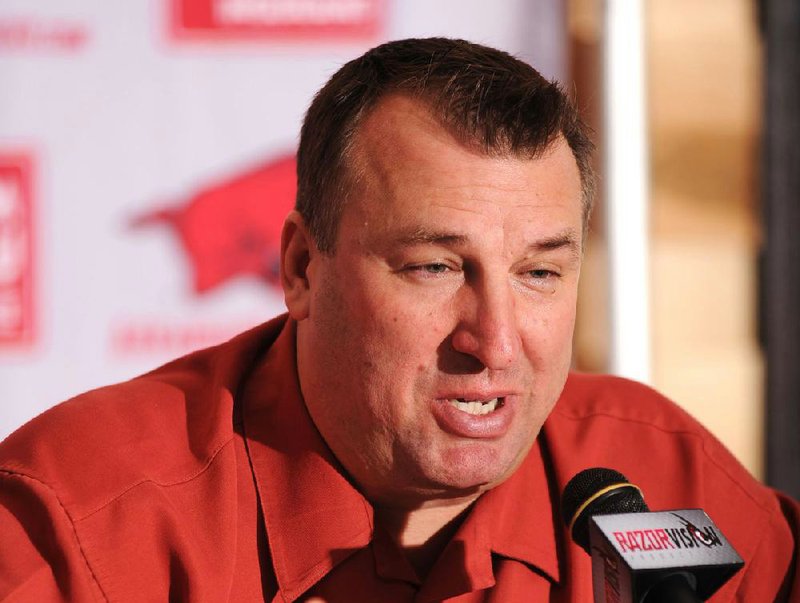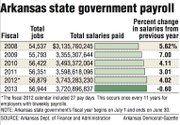
Search below for state workers who make at least $100,000 or search for ALL employee pay in our state salary database and our college and university salary database.
RELATED ARTICLES
http://www.arkansas…">Top non-UAMS state higher education employee payhttp://www.arkansas…">Top non-UAMS state nonhigher-education employee payhttp://www.arkansas…">Top UAMS state employee pay
The number of state employees making at least $100,000 increased this fiscal year by 162 to 2,466.
Most of them work at the state’s higher-education institutions, where the number of state employees who are paid at least $100,000 a year increased by 118 to 2,116.
At the University of Arkansas for Medical Sciences, the number of state employees paid at least $100,000 increased by 50 to 1,152.
Funding for the 2,466 highest-earning employees comes from a variety of federal, state and private sources, including tuition, patient-care revenue and taxes.
The Arkansas Democrat-Gazette compiled these figures from more than four dozen repositories of state-employee salary information, and they reflect salaries from earlier in the fiscal year, which began July 1.
Gov. Mike Beebe said he presumes that the growth in the number of employees who are paid at least $100,000 a year at the state’s two-year and four-year colleges is a result of “market demand.”
“We don’t scrutinize constitutionally higher ed to the same degree that you constitutionally scrutinize other agencies,” Beebe said, referring to Amendment 33 of the Arkansas Constitution, which grants some constitutional independence to higher-education institutions’ boards, whose members are appointed by the governor as openings occur.
“They have some degree of constitutional independence, but obviously their line-item [maximum salaries] are set by the Legislature,” said Beebe, a Democrat who will leave office in January after completing his second four-year term.
The growth in the number of the state employees with salaries of at least $100,000 this fiscal year is consistent with the increases in each of the past five fiscal years, which have ranged from 129 to 164 a year, with most of the growth driven by the state’s higher-education institutions, including UAMS.
State Sen. Uvalde Lindsey, D-Fayetteville, co-chairman of the Personnel Subcommittee of the Joint Budget Committee, said it’s obvious that “the docs … are going to be paid big bucks” at UAMS to ensure that good teachers are enticed there.
“The market dictates that,” he said. “You shortchange the next generation of doctors if you don’t have the best and brightest teaching them.”
Joint Budget Committee Co-Chairman Sen. Duncan Baird, R-Lowell, said that the Legislature has tried in recent years to reduce the growth in the number of state employees, saying the cost of state government is driven largely by its personnel costs.
The number of full-time state employees increased by 65 in fiscal 2013, the second-smallest growth in the number of state employees during at least the past 27 years, state records show.
The state ended fiscal 2013 with 56,944 full-time employees - up from 56,879 at the end of fiscal 2012 - according to a report from state Budget Administrator Brandon Sharp. The number of full time employees at the state’s two- and four-year colleges increased by 198 to 25,042 in fiscal 2013, while the ranks at the state’s other agencies dipped by 133 to 31,902.
COACHES TOP THE LIST
The top-paid state employee is Bret Bielema, head football coach at the University of Arkansas at Fayetteville. His salary is $3.3 million this fiscal year.
UA hired him in December 2012 from the University of Wisconsin, where he coached for seven years and led the Badgers to three-consecutive Rose Bowl games.
The salary of the previous noninterim Razorback head football coach, Bobby Petrino, was $2.95 million. Petrino was fired in April 2011 after trying to cover up his relationship with a 25-year-old female employee of the football program.
Mike Anderson, UA’s head men’s basketball coach, is the second-highest-paid state employee with a salary of $2.2 million.
Formerly head coach at the University of Missouri and the University of Alabama at Birmingham, Anderson was hired in March 2011 to succeed John Pelphrey, whose salary was $1.245 million before he was fired.
The third-highest-paid state employee is Michiaki Imamura, chief of pediatric and congenital cardiothoracic surgery at Arkansas Children’s Hospital in Little Rock, at $1.072 million. He began working at UAMS in the fall of 2010, succeeding Robert Jaquiss, whose salary was $1.1 million before he left to take a job at Duke Children’s Hospital in North Carolina.
UA Athletic Director Jeff Long is the fourth-highest paid state employee at $865,000.
Long was hired in September 2007 from the University of Pittsburgh, where he was athletic director, to replace Frank Broyles, Arkansas’ athletic director from 1973-2008 and head football coach from 1958-1976.
UAMS SALARIES
The number of UAMS employees who are paid at least $100,000 increased from 1,102 to 1,152 this fiscal year.
That’s the result of the medical school adding numerous programs, UAMS spokesman Leslie Taylor said.
UAMS’ fiscal 2014 budget totals $1.25 billion, and 73 percent of its revenue - $906.5 million - comes from patient care and income generated by health-care professionals working in the institution’s clinical programs, she said. Other major funding sources for fiscal 2014 include $125 million in research grants and contracts, a state appropriation of $113.6 million, gifts and other revenue of $69.1 million, and tuition and fees of $35.9 million.
In fiscal 2013, UAMS’ budget totaled $1.26 billion including $901.6 million from patient care, $155.2 million from research grants and contracts, $115 million from state appropriations, $64.1 million from gifts and other revenue, and $32.4 million from tuition and fees.
With cuts in federal research funding and state funding and “our high rate of charity care, UAMS must not only look for ways to increase clinical revenue, so that we will be able to not only fund our hospital and clinics, but also to fund our education and research missions,” Taylor said.
“This requires the hiring of doctors and other specially trained individuals [and] we compete with other institutions around the country for these individuals and we must offer competitive salaries.”
AGENCY DIRECTORS
The number of state employees making at least $100,000 a year who work for state agencies other than the state’s higher-education institutions increased by 44 to 350 over the past year.
State Education Commissioner Tom Kimbrell is the highest paid of these employees with a salary of $228,887. Nathaniel Smith, director of the state Health Department, is the second highest paid with salary of $215,448.
Fifteen state agency directors, deputy directors and other employees saw their salaries climb above $100,000 because state officials lifted limits on pay raises that had been in place since 2009 for these those employees, said state personnel administrator Kay Terry.
The higher pay for top state officials drew criticism from state Sen. Alan Clark, R-Lonsdale, who unsuccessfully pushed in the Legislature’s recent fiscal session to require lawmakers’ approval of pay raises for state agency directors and deputy directors.
EMPLOYEE RAISES
The 2013 Legislature approved, for fiscal 2014, 2 percent cost-of-living raises for about 30,000 state employees who don’t work at the state’s higher-education institutions, after legislators declined to approve cost-of-living raises for these employees in fiscal 2012 and fiscal 2013.
The colleges and universities decide on their own whether to grant pay raises, and they can tap funding sources other than state appropriations, such as tuition and fees.
The 2014 Legislature authorized for fiscal 2015, which begins July 1, 1 percent cost of-living raises for the 30,000 state employees who don’t work at the colleges and universities, at an estimated cost of $5 million in general revenue. The raises are dependent on the state taking in sufficient revenue.
And it’s unclear whether the raises will go into effect. Lawmakers approved a sales tax exemption for sand and proppants used in the oil and gas industry, overriding Beebe’s veto.
The state Department of Finance and Administration says the tax cut will reduce tax revenue by about $5.1 million, including $3.5 million in state general revenue.
And because the raise was listed as a lower priority for funding, below the A and B list of priorities, the funding won’t be available for the raise if the state fails to raise sufficient revenue in fiscal 2015.
Unless the Beebe administration revises the general revenue forecast for fiscal 2015, and “there is no indication it will [happen],” Beebe said, the 1 percent cost-of-living raises in fiscal 2015 “won’t be funded because it’s in B1.”
“Theoretically, things could change throughout the course of a fiscal year, and it will be up to the next governor to be conservative or liberal in their budgeting,” Beebe said in an interview last week. “From my standpoint, you wouldn’t make a decision like that in the first few months of a fiscal year in terms of changing that forecast.”
Front Section, Pages 1 on 03/30/2014


